Brick Testing and ASTM Requirements
Words: David Biggs, Steven Judd
Words: Steven Judd
Photos: Steven Judd
So why do bricks need to be tested, anyway? A brick is a brick, is a brick, aren’t they? They are all the same, aren’t they? There are many reasons why it is necessary and important to have brick tested because they are not all the same. For this article, we will focus on brick manufactured exclusively from clay or shale. [There are some types of “brick” that are manufactured from cementitious mixes (cement and aggregate) that are called “brick,” but those are not addressed in this article.]
There are hundreds of brick manufacturing facilities in the United States and Canada, and they all, collectively, use hundreds of different types of clays and shales and are fired in various types of kilns (primarily linear kilns and shuttle kilns). Each clay mix and each kiln type will produce fired brick material that can have properties substantially different from one another, properties like density, absorption, and compressive strength, which are key factors related to durability in freezing climates, which comprise the vast majority of the US and Canada. Abrasion resistance (for pavers) and ‘breaking strength’ (bending mode, for heavy vehicular pavers) are other important properties. Then there are also other types of brick used for things such as flue liners (refractory brick), ovens, kilns, and subterranean sewers and aqueducts, to name a few; even water permeable paving. The various uses of brick have different physical requirements that must be determined via testing.
Designers of construction projects generally will/should specify the brick properties required for the design based on the specific intended use. Most often, the brick properties will be defined by referencing one or more industry-recognized manufacturing standards developed and published by ASTM International (used to be just ASTM, which stands for American Society for Testing and Materials). The brick manufacturer must then provide proof of compliance with the noted project standards, usually via test reports and a Letter of Certification (LOC). For projects in Canada, the reference standard for brick is the Canadian Standards Association CSA-A82, which covers Face Brick and Hollow Clay Masonry (HCM) and matches closely with ASTM C216 (Facing Brick) and C652 (Hollow Clay Masonry – ‘HCM’).
One of the main reasons for testing is to provide documentation that the material proposed for use complies with the ASTM (or CSA) manufacturing standards that are (or should be) stated in the project specifications. Additionally, the testing, when specifically requested, can indicate the likely potential to effloresce (Efflorescence testing), and it can provide the Initial Rate of Absorption (IRA), which is an indicator to the Mason that can be used by the Mason when mixing mortar.
All ASTM (and CSA) criteria relate to newly manufactured materials, not reclaimed, re-used, or salvaged brick. Testing of reclaimed or salvaged brick can be performed in the same way as newly manufactured brick, but there are no pass/fail criteria that apply to those bricks. One can acquire information about the reclaimed/re-used/salvaged brick via testing that produces the specific material properties and will provide indications about durability, but those values are not relevant to compliance with newly manufactured brick material.
Next, we’ll address the typical ASTM references. For Facing Brick (or “face brick”; we’ll use the term ‘Face Brick’ in this article), one would typically reference ASTM C216. Face Brick is typically, and most often, used for anchored veneer in a cavity wall application, which is common in residential and some commercial construction. Structural Brick, or HCM, should reference ASTM C652. HCM are used in a similar fashion as CMU – a masonry unit with large openings (cells = void area larger than 1.5 sq. in.) intended to be filled with reinforcing and grout or insulation – to build structural masonry walls; load bearing walls and shear walls – or to remain unfilled. Pedestrian and Light Traffic Paver Brick should reference ASTM C902, which is typically used for sidewalks, patios, and residential driveways. Heavy Traffic Paving Brick should reference ASTM C1272, which is used for streets and/or crosswalks in main vehicular thoroughfares used by commercial trucks and emergency vehicles.
Thin Brick should reference ASTM C1088 or, possibly, PCI Specification for Embedded Thin Brick. Thin bricks are used in many ways but predominantly hand-applied over base materials such as stucco, cement backer board, other masonry (like CMU), or concrete walls. They can be installed using modular panels of various sorts. Thin brick can also be used to embed in site-cast tilt-up concrete or precast concrete elements. These standards are reviewed and updated as needed, but the review interval should not exceed every five years.
NOTE: Unlike ASTM specifications, the PCI specification document is not a consensus document generated through open debate with balanced participation by a broad spectrum of industry producers, designers, users, and general interest parties (including academics and researchers) and through public comment periods with a requirement to resolve all negative ballots. After a thorough review of the PCI Specification document by BIA and various BIA members, suggestions were made directly to PCI to modify the existing PCI specification document to represent a broader spectrum of the masonry industry. The majority of those suggestions were dismissed without debate or justification. Quoting BIA, “We recognize now that the intent is to keep this a proprietary document under the guise of consensus.” The PCI Specification is a fairly recent document (2006) in terms of the history of thin brick, and many precasters are satisfied with and regularly use thin brick manufactured to ASTM C1088 Type TBX standards (“Types” are discussed below), and have done so for many years. Two critical factors for adhered and embedded thin brick is making sure the backs of the brick are clean, and the Type of form liner used is appropriate to accommodate the inherent tolerances. Enough said on that.
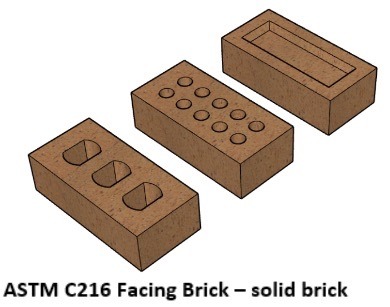
Point of clarification: In terms of ASTM C216 Facing Brick (Face Brick), the brick is considered “solid” if there are no voids or if voids (cores or cells) in the units are less than 25% of the gross bedding plane area. Typical Face Brick has cores (voids less than 1.5 sq. in). Frogs (recesses in one bedding face) are permitted. [Case 1: Frogs are allowed if no more than 3/8” deep and no closer than ¾” to any edge of the brick. Case 2: Frogs may be deeper than 3/8” when the area of the frog does not exceed 25% of the bedding plane.] So “solid” bricks can have cores (or frogs). Building bricks (ASTM C62) are solid, with no voids, used “where external appearance is not a requirement.”
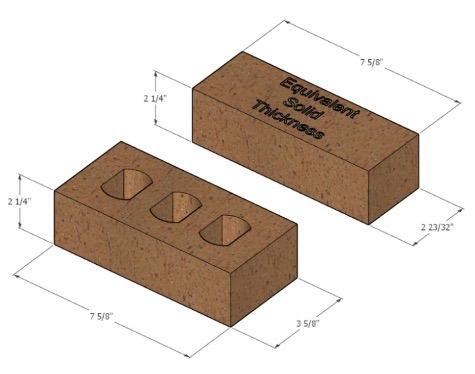
It is important to note that the 25% maximum void area for Face Brick, applied to the typical 4” nominal depth units (3.625” actual), generates an equivalent solid thickness of 2-23/32” (2.71 inches), which, not coincidentally, complies with the minimum equivalent solid thickness of 2.7 inches per the 2018 and 2021 IBC code requirement (Section 722 Calculated Fire Resistance, Table 722.4.1(1)) for a 1-hour fire-resistive rating for the brick alone. Face bricks that are 3.625” deep (actual) with larger voids, which qualify under ASTM C652, do not meet that 1-hour fire-resistive rating requirement, which can impact the wall design. Thinner units, such as King and Queen size brick with a 3” (actual) bed depth (or less), which have the 25% maximum void area allowed for C216 Facing Brick, also do not comply with the Table of 1-hour fire-resistive ratings based on the equivalent solid thickness for the brick alone. They would need a reduced void area – something less than 9.7% void area for the 3” (actual) depth units to provide the equivalent solid thickness to attain the 1-hour fire-resistance rating for the brick alone.

For Face Brick and HCM, Grade SW (“SW” = Severe Weathering) and for Thin Brick, Grade Exterior are the default Grades, if not otherwise specified. This means the manufactured material must meet the Severe Weathering (Grade Exterior for Thin Brick) criteria specified in the respective ASTM documents when no specific grade is required by the construction documents. Grade SW primarily consists of low absorption for all three profiles (Face Brick, HCM, and Thin Brick) and moderate gross area compressive strength for Face Brick and HCM. There is no compressive strength requirement for Thin Brick. There are several compliance paths for Grade SW or Grade Exterior Brick. The typical criteria are based on a 5-hour boiling water absorption percent of not more than 17.0% based on the average of 5 samples tested (with no single sample exceeding 20.0% absorption) and the Saturation Coefficient (“SC” = 24-hr cold water absorption % divided by the 5-hr boiling water absorption %) of 0.78 based on the average of 5 samples tested (with no single sample greater than 0.80), and, lastly, for Face Brick and HCM, the minimum gross area compressive strength of 3,000 psi, based on the average of 5 samples tested (with no single sample less than 2,500 psi). If Grade SW (or Grade Exterior) criteria can’t be met, the brick is generally classified as Grade MW (Moderate Weathering) or Grade Interior, for thin brick, which has slightly less stringent absorption and compressive strength criteria, and has limited areas of acceptable use – primarily the south half of Florida, the southern-most portions of Texas, the southern coastal area of California and the South-western-ish portion of Arizona. Refer to ASTM C216, C652, or C1088 for a Weathering Index Map, something like this:
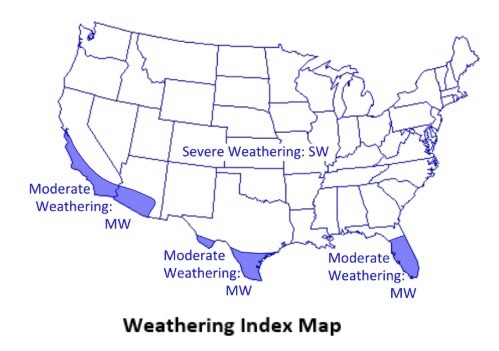
There is an alternative absorption criterion for Grade SW or Grade Exterior such that the SC can be waived if the 24-hour cold water absorption is no more than 8.0% for any of the tested samples. The 5-hour boiling water absorption limit and minimum compressive strength criteria are still in force. Lastly, if the absorption limits are exceeded, the sample can be subjected to a 50-cycle freeze-thaw test. If the appearance doesn’t change (cracks or chips) and the weight loss due to flaking or spalling is no greater than 0.5% of the dry sample weight, the absorption criteria can be waived, and it is considered acceptable as long as the minimum compressive strength complies. The standard freeze-thaw test method (Method A) outlined in ASTM C67 can take more than 12 weeks to perform, whereas the recently adopted alternative rapid freeze-thaw method (Method B) may only take a little over two weeks to perform.
For Pedestrian and Light Traffic Paver Brick (ASTM C902), Class SX is the default and is a little different than the three other brick types for Grade SW (Severe Weathering): The 24-hour cold water absorption is not allowed to be greater than 8.0% based on the average of 5 samples tested (with no single sample exceeding 11.0%); the SC shall not be more than 0.78 based on the average of 5 samples tested (with no single sample greater than 0.80); and, the net area gross compressive strength must be no less than 8,000 psi, based on the average of 5 samples tested (with no single sample less than 7,000 psi).
For Heavy Vehicular Paver Brick (ASTM C1272), there are basically two Types. Type R is for brick intended to be set in mortar supported by an adequate concrete base or set with a bituminous bed supported by an asphalt or concrete base. Type F is for pavers set in an aggregate setting bed (usually sand) with aggregate joints (usually sand) and supported by an adequate base (generally layers of differentially graded aggregate similar to, or identical to, a typical layered road base). Both Type R and Type F require the 24-hour cold water absorption to be not more than 6.0% based on the average of 5 samples tested (with no single sample exceeding 7.0%). Type R has a minimum gross area compressive strength of at least 8,000 psi, based on the average of 5 samples tested (with no single sample less than 7,000 psi). Type F has a minimum gross area compressive strength of at least 10,000 psi, based on the average of 5 samples tested (with no single sample less than 8,800 psi). Additionally, Type F pavers must have a minimum breaking load (in bending) of 475 lbs, based on the average of 5 samples tested (with no single sample less than 333 lbs.)
Measuring the brick to determine whether the units fall within acceptable tolerances is also part of “testing” brick. Depth (or width), height, and length (usually referenced in that order: D x H x L) are measured for compliance given the Type specified. In addition, Face Brick, HCM, Thin Brick, and Paving Brick have distortion (warpage) tolerances. Face Brick is currently the only profile with out-of-square tolerances (for the stretcher face). For appearance and tolerance issues of Face Brick, HCM, Thin Brick, and Paving Brick, Type FBS, Type HBS, Type TBS, and Application PS, respectively, are the default unless something else is specified. FBS, HBS, TBS, and PS are considered ‘standard,’ with typical tolerances. If tighter tolerances for dimensions, distortion, chips, and cracks are desired or required, then Type FBX, Type HBX, Type TBX, and Application PX should be specified. Application PX is required for Type F Heavy Vehicular Paving Brick. Grade SW (Severe Weathering), and Grade Exterior for Thin Brick, and FBX, HBX, TBX, and PX are the most stringent criteria addressed in the various ASTM specifications for manufactured brick made from clay or shale. These Type “X” specifications represent the best weathering properties and the tightest tolerances for size and distortion, as well as chips and cracks. Some manufacturers may have a premium price for these more stringent criteria. It is worth an inquiry.
When measuring bricks for size compliance, one does not just measure the face dimensions. Each of the three cardinal dimensions (depth, height, length) is measured on four faces and averaged. For example, the height of the brick is determined by measuring and recording (to 1/64”) the height at the middle of the face, the height at the middle of the left end, the height at the middle of the back face, and the height at the middle of the right end, and then all four measurements are averaged and recorded (to 1/32”) as the height. The same process is used for the other two cardinal dimensions (depth and length).
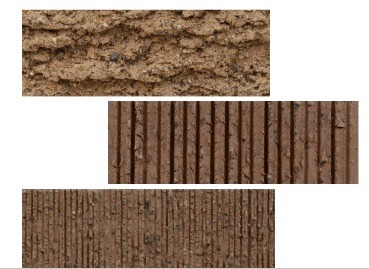
Types FBA, HBA, and TBA, for Face Brick, HCM, and Thin Brick, respectively, may be available from various manufacturers with a wide range of surface textures (a few examples shown to the right) that relate to brick that have aggressive textures applied during manufacturing that alter the typical dimensions and distortions, such as rolled edges or rolled, dented, or debossed surfaces, scratched or otherwise roughened surfaces, or some other mechanical distressing to create a specific mottled edge or surface. These “Architectural” bricks do not have predefined dimensional tolerances or limits on chips due to the nature of the distressed edges or surfaces and should be discussed between the designers and the manufacturer early in the design process. It is best to have an approved sample that demonstrates the size variability and the acceptable level of textures and chips.
Hopefully, based on the above discussion, one can conclude that testing of the brick is necessary in order to determine if the brick complies with the project requirements that reference any of the aforementioned ASTM Standard Specifications. If the Type and Grade are not specified, default standards still apply, which are Grade SW, or Grade Exterior, and Type FBS, HBS, TBS, or PS, for Face brick, HCM, Thin Brick, and Pedestrian and Light Traffic Paving Brick, respectively.
Below is a series of tables to help categorize the various brick attributes. This synopsis and expanded information can be found on the BIA website (www.gobrick.com) in the Tech Notes area, Tech Note 9A.
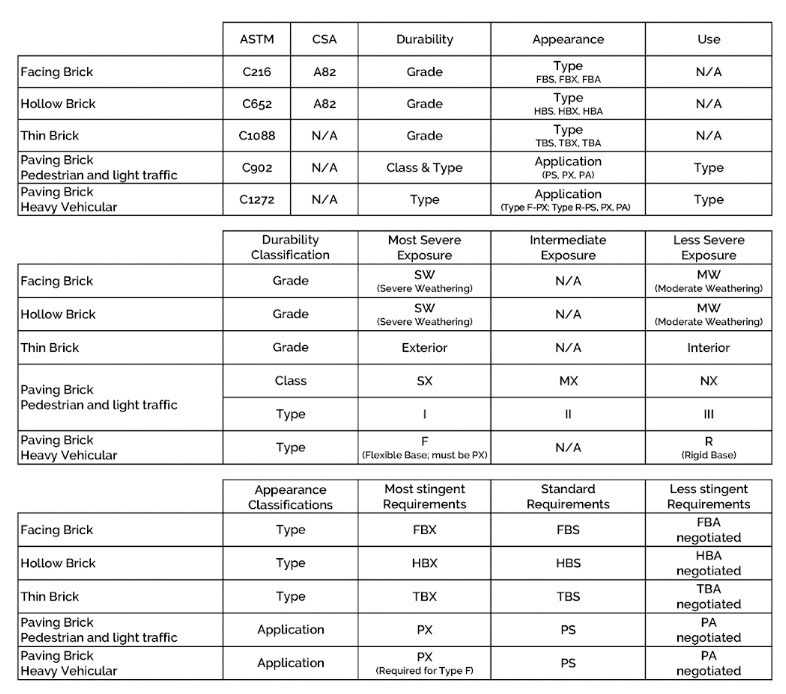
BIA has many resources available to the public which cover a wide range of issues and can be accessed to help learn more about brick and its use. BIA has 71 technical notes, 20 brick briefs, and several FAQs that are very useful and should be a “go-to” resource for those in the brick masonry business.
Brick testing is a necessity to ensure that the brick material being delivered to the project site meets the appropriate standards and minimum required properties. As always, the mason should have a QA/QC program in place to assess the condition of the brick as received, review test data and certifications, and then install only units that pass the QA/QC scrutiny. Once units are placed in the wall, the mason is responsible for resolving any issues related to the quality of the brick. Placing the brick in use means it is deemed acceptable for use.